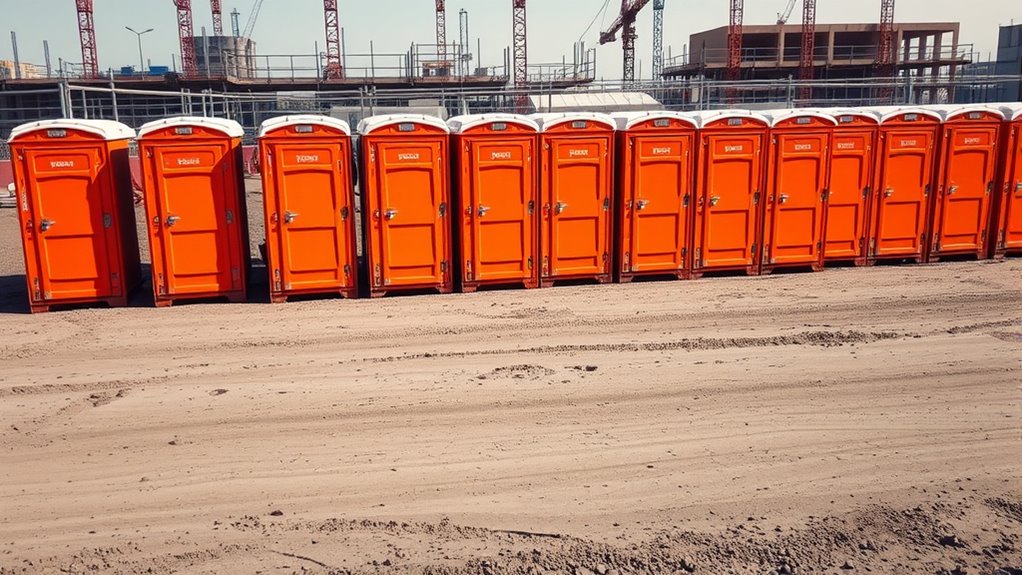Analyzing porta potty data helps you identify peak usage times and seasonal trends on modern worksites. You can schedule maintenance more efficiently by aligning services with actual demand, reducing waste, and preventing overflows. This approach minimizes environmental impacts and saves money by avoiding unnecessary servicing. Understanding these patterns also supports proactive planning and sustainability goals. If you’re interested, there’s more to uncover about optimizing sanitation practices with data insights.
Key Takeaways
- Usage data highlights peak times and days, enabling targeted maintenance during high-demand periods.
- Analyzing patterns helps optimize servicing schedules, reducing unnecessary visits and environmental impact.
- Trends reveal site-specific demand fluctuations, supporting adaptive resource allocation for efficiency.
- Data-driven insights prevent overflows and hygiene issues by aligning cleaning frequency with actual use.
- Monitoring usage patterns promotes sustainable practices by minimizing water, supplies, and transportation emissions.

In today’s event-driven world, analyzing data from porta potties might seem unusual, but it offers valuable insights for event organizers, construction managers, and sanitation companies. By examining usage patterns, you can better understand how these facilities are being used and how to optimize their operation. This data not only helps improve efficiency but also minimizes the environmental impact of sanitation services on your site. When you track how often porta potties are filled or emptied, you gain a clearer picture of demand, allowing you to plan maintenance schedules more accurately. This prevents over-servicing, which can waste resources, and under-servicing, which leads to uncomfortable conditions and potential health hazards.
Understanding usage trends can reveal peak times and days when porta potties are most in demand. If you notice a spike in usage during certain hours, you can increase maintenance or servicing during those periods, reducing the likelihood of overflows or foul odors. Conversely, during periods of low activity, maintenance can be scaled back, saving costs and resources. This targeted approach ensures that each porta potty is serviced just enough to meet demand, reducing unnecessary waste and lowering your environmental footprint.
Tracking usage patterns helps optimize porta potty servicing and reduce waste and environmental impact.
Additionally, analyzing data helps you assess the environmental impact of your sanitation practices. Frequent, unnecessary servicing not only wastes water and cleaning supplies but also contributes to emissions from transportation and maintenance activities. By aligning servicing schedules with actual usage, you can considerably reduce these impacts. This is especially important on large worksites or events where numerous porta potties are deployed. Using data-driven insights, you can implement eco-friendly practices that support sustainability goals while maintaining high standards of hygiene and comfort for users.
Moreover, incorporating high-quality data analytics tools can further refine your understanding of usage patterns and optimize your sanitation operations. Maintenance scheduling becomes more precise when you base it on real-time data rather than fixed routines. Instead of adhering to a generic schedule, you adapt your approach according to actual usage patterns. This leads to more efficient resource allocation, less downtime, and better service quality. For example, if data shows a consistent increase in demand during certain weeks or phases of a project, you can proactively prepare by scheduling more frequent servicing to prevent issues before they arise.
Frequently Asked Questions
How Do Porta Potty Usage Patterns Vary by Industry?
You’ll notice that industry-specific hygiene needs influence porta potty usage frequency markedly. Construction sites, for example, typically see higher usage due to the physical nature of work and limited facilities, while office environments have lower, more consistent patterns. Understanding these variations helps you optimize sanitation services, ensuring adequate supply and maintenance tailored to each industry’s demands, ultimately maintaining cleanliness and worker satisfaction across different worksite types.
What Environmental Factors Influence Porta Potty Usage?
You should consider how weather patterns and crowd density influence porta potty usage. Warm, rainy, or hot weather often increases demand, as people need more relief options. High crowd density, like during events or busy workdays, also boosts usage because more individuals are present and active. Monitoring these environmental factors helps you optimize sanitation services, ensuring sufficient facilities are available when conditions lead to higher demand.
Can Data Predict Future Porta Potty Maintenance Needs?
You can use data to predict future porta potty maintenance needs through predictive maintenance and usage forecasting. By analyzing usage patterns, cleaning frequency, and environmental factors, you identify when a unit will likely need servicing. This proactive approach minimizes downtime and improves efficiency. With accurate data insights, you’ll schedule maintenance more effectively, ensuring sanitation standards are met and reducing unexpected issues on worksites.
How Does Porta Potty Data Impact Overall Site Safety?
You can improve site safety by monitoring porta potty data, as it helps guarantee hygiene standards and sanitation compliance are met. When usage patterns indicate overcrowding or neglect, you can act promptly to schedule cleaning or maintenance. This proactive approach reduces health risks, prevents accidents, and maintains a safe, clean environment. Ultimately, data-driven insights empower you to uphold safety and hygiene standards effectively across your worksite.
Are There Privacy Concerns With Collecting Porta Potty Usage Data?
You might wonder about privacy concerns with porta potty data collection. Significantly, over 80% of workers feel comfortable if data is anonymized. While data security is essential, most users trust that their privacy stays intact when usage info is aggregated. However, it’s vital to address privacy concerns by implementing strict data security measures and transparent policies, ensuring everyone feels confident that their personal privacy isn’t compromised.
Conclusion
By analyzing porta potty data, you gain valuable insights into worksite behaviors and efficiency. These patterns help you spot issues before they become problems and optimize resource allocation. Remember, understanding the subtle signs can make all the difference—it’s often the little things that tell the biggest story. So, keep paying attention to the data, and you’ll be surprised how much you can improve your operations. After all, knowledge is power, and it’s worth its weight in gold.









